敦煌莫高窟(英文ppt介绍)资料讲解共50页
- 格式:ppt
- 大小:7.57 MB
- 文档页数:50
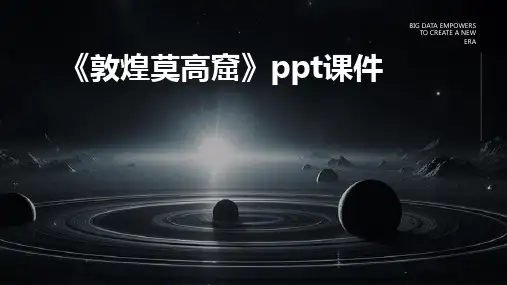
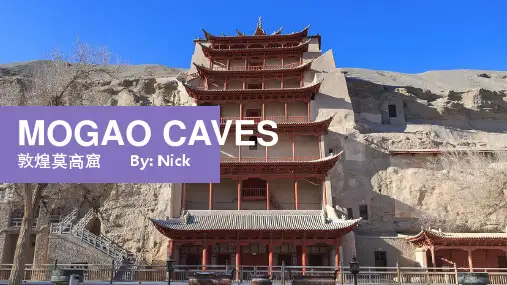
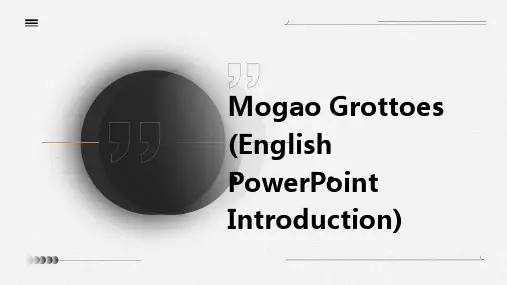
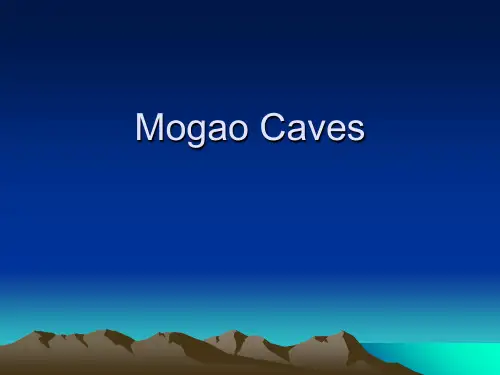
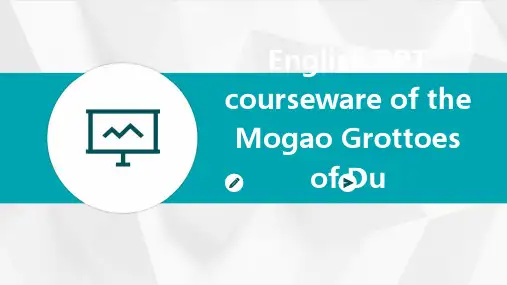
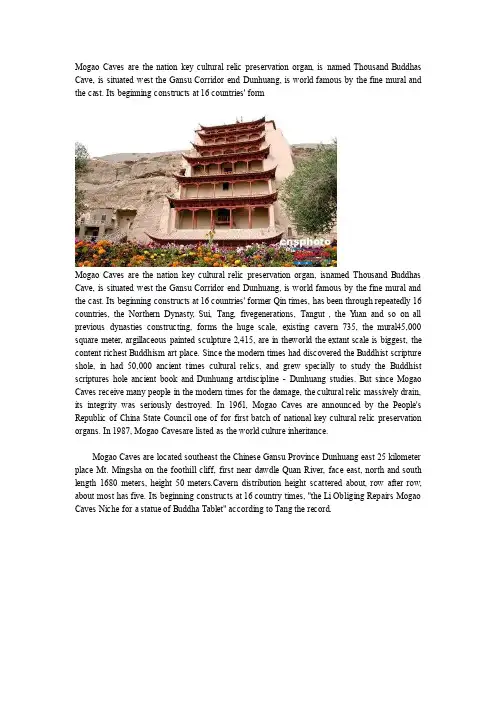
Mogao Caves are the nation key cultural relic preservation organ, is named Thousand Buddhas Cave, is situated west the Gansu Corridor end Dunhuang, is world famous by the fine mural and the cast. Its beginning constructs at 16 countries' formMogao Caves are the nation key cultural relic preservation organ, isnamed Thousand Buddhas Cave, is situated west the Gansu Corridor end Dunhuang, is world famous by the fine mural and the cast. Its beginning constructs at 16 countries' former Qin times, has been through repeatedly 16 countries, the Northern Dynasty, Sui, Tang, fivegenerations, Tangut , the Y uan and so on all previous dynasties constructing, forms the huge scale, existing cavern 735, the mural45,000 square meter, argillaceous painted sculpture 2,415, are in theworld the extant scale is biggest, the content richest Buddhism art place. Since the modern times had discovered the Buddhist scripture shole, in had 50,000 ancient times cultural relics, and grew specially to study the Buddhist scriptures hole ancient book and Dunhuang artdiscipline - Dunhuang studies. But since Mogao Caves receive many people in the modern times for the damage, the cultural relic massively drain, its integrity was seriously destroyed. In 1961, Mogao Caves are announced by the People's Republic of China State Council one of for first batch of national key cultural relic preservation organs. In 1987, Mogao Cavesare listed as the world culture inheritance.Mogao Caves are located southeast the Chinese Gansu Province Dunhuang east 25 kilometer place Mt. Mingsha on the foothill cliff, first near dawdle Quan River, face east, north and south length 1680 meters, height 50 meters.Cavern distribution height scattered about, row after row, about most has five. Its beginning constructs at 16 country times, "the Li Obliging Repairs Mogao Caves Niche for a statue of Buddha Tablet" according to Tang the record.Former Qin establishes a reign title for two years (366 years), the Buddhist priest happy goes via this mountain, sees the golden light sparkle suddenly, if presently ten thousand Buddha, therefore then opened cutting on the dike the first cavern.Hereafter the law good Zen master and so on continues in this to construct the hole to repair the imperial sacrifices, is called the desert high hole, Italy is the desert high place.Because later generation desert and not general, then renames as Mogao Caves.When Northern Wei Dynasty, Western Wei Dynasty and Northern Zhou Dynasty, the ruler respects and believes in Buddhism, the rock cave construction has the nobility support, the development is quick.The Sui and Tang dynasties time, along with Silk Road prosperity, Mogao Caves is prosperous, when Wu Zetian has cavern thousand.After the Anlushan Rebellion, Dunhuang successively and turns over to the troops fighting in a good cause by Turfan to seize, but the statuary activity too greatly has not been affected.The Northern Song Dynasty, the tangut and the Y uan Dynasty, Mogao Caves gradually hasten the decline, only repaired the previous dynasty hole room primarily, newly built extremely few.After Y uan Dynasty, along with Silk Road abandoning, Mogao Caves also stopped constructing and is neglected gradually in common people's field of vision.After clear Kanghsi 40 years (in 1701), here only then again manner attention.The modern times, people usual name it “Thousand Buddhas Cave.The Mogao Caves extant Northern Wei Dynasty to Y uan cavern 735, divides into the north and south two areas.South the area is Mogao Caves' main body, is engaged in the religious activities for the clergy the place, some 487 caverns, have the mural or make an idol.North the area has 248 caverns, in which only then 5 existence murals or makes an idol,But after other all is the clergy leads a pious life the place which, the housing and the death buries, has life facilities and so on the adobe bed, stove kang, flue, niche, desk lamp.Two area total 492 cavern existence mural and makes an idol, has the mural 45,000 square meter, the argillaceous painted sculpture 2415, Tang Songmu constructs cliff eave 5, as well as several thousand lotus flower pillars, spread out on the floor the decorative brick and so on.。
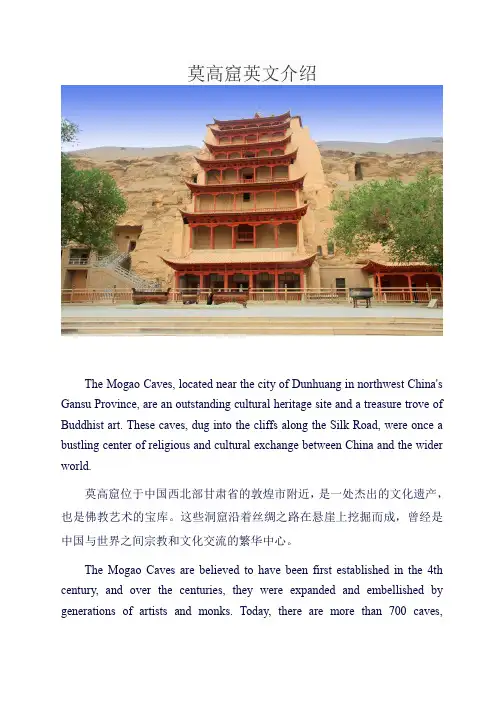
莫高窟英文介绍The Mogao Caves, located near the city of Dunhuang in northwest China's Gansu Province, are an outstanding cultural heritage site and a treasure trove of Buddhist art. These caves, dug into the cliffs along the Silk Road, were once a bustling center of religious and cultural exchange between China and the wider world.莫高窟位于中国西北部甘肃省的敦煌市附近,是一处杰出的文化遗产,也是佛教艺术的宝库。
这些洞窟沿着丝绸之路在悬崖上挖掘而成,曾经是中国与世界之间宗教和文化交流的繁华中心。
The Mogao Caves are believed to have been first established in the 4th century, and over the centuries, they were expanded and embellished by generations of artists and monks. Today, there are more than 700 caves,containing thousands of intricate murals and statues that depict Buddhist legends, historical events, and daily life in ancient China.莫高窟始建于公元4世纪,几个世纪以来,经过一代又一代艺术家和僧侣的不断扩建和装饰。
如今,这里拥有700多个洞窟,内有数千幅错综复杂的壁画和雕像,描绘了佛教传说、历史事件和古代中国的日常生活。
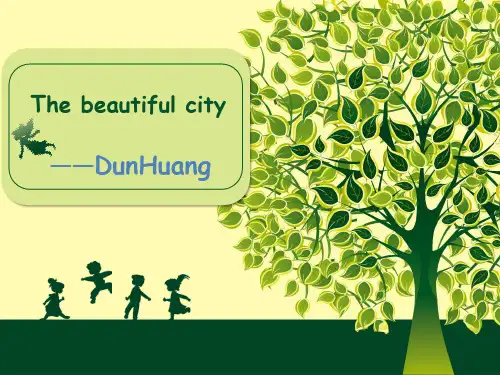
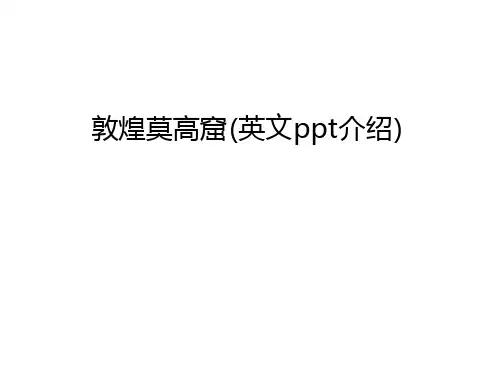
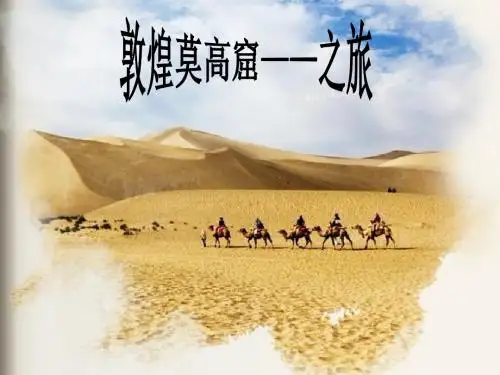
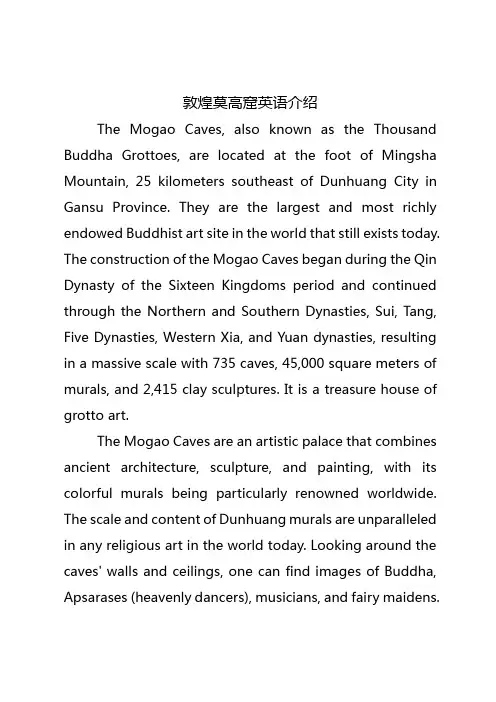
敦煌莫高窟英语介绍The Mogao Caves, also known as the Thousand Buddha Grottoes, are located at the foot of Mingsha Mountain, 25 kilometers southeast of Dunhuang City in Gansu Province. They are the largest and most richly endowed Buddhist art site in the world that still exists today. The construction of the Mogao Caves began during the Qin Dynasty of the Sixteen Kingdoms period and continued through the Northern and Southern Dynasties, Sui, Tang, Five Dynasties, Western Xia, and Yuan dynasties, resulting in a massive scale with 735 caves, 45,000 square meters of murals, and 2,415 clay sculptures. It is a treasure house of grotto art.The Mogao Caves are an artistic palace that combines ancient architecture, sculpture, and painting, with its colorful murals being particularly renowned worldwide. The scale and content of Dunhuang murals are unparalleled in any religious art in the world today. Looking around the caves' walls and ceilings, one can find images of Buddha, Apsarases (heavenly dancers), musicians, and fairy maidens.The Mogao Caves are a large grotto temple that integrates painting, sculpture, and architectural art. Its main grotto types include meditation caves, central tower caves, hall caves, central Buddha altar caves, three-alcove caves with four walls, giant statue caves, and Nirvana caves. The sizes of the various caves vary greatly; the largest, Cave 16, covers an area of 268 square meters, while the smallest, Cave 37, is only a few inches high. There used to be wooden halls outside the caves connected by corridors and plank roads, but most have now disappeared.In conclusion, the Mogao Caves are a place worth visiting for their long history and profound cultural heritage. They are well-preserved and allow visitors to experience the charm of ancient civilization up close.翻译:敦煌莫高窟,又称千佛洞,位于甘肃省敦煌市东南25公里处的鸣沙山麓脚下,是世界上现存规模最大、内容最丰富的佛教艺术地。
用英文介绍敦煌莫高窟The Mogao Caves, also known as the Dunhuang Caves, are a network of Buddhist cave temples located near the oasis town of Dunhuang in Gansu Province, China. The caves are renowned for their exquisite murals and sculptures, which date back to the 4th century AD. The site is one of the most important cultural heritage sites in China and has been designated a UNESCO World Heritage Site.The Mogao Caves were first constructed in the 4th century AD and continued to be expanded and embellished over the following centuries. The caves were created as places of worship and meditation for Buddhist monks and pilgrims, and many of the murals and sculptures depict scenes from Buddhist scriptures and teachings. The caves also served as repositories for Buddhist scriptures and artifacts, with thousands of manuscripts and paintings found within the caves.One of the most remarkable features of the Mogao Cavesis the diversity of artistic styles and influences found in the murals and sculptures. The artwork in the cavesreflects a blend of Chinese, Indian, and Central Asian artistic traditions, showcasing the cultural exchange and religious syncretism that characterized the Silk Road region during this period. The caves also contain some of the earliest known examples of Chinese landscape painting, with detailed depictions of mountains, rivers, and forests.In addition to their artistic significance, the Mogao Caves are also important for their historical and archaeological value. The caves provide valuable insights into the religious beliefs, social practices, and artistic achievements of the various cultures that inhabited the region over the centuries. The discovery of the Dunhuang Manuscripts in the early 20th century further enhanced the site's importance, shedding light on the intellectual and cultural life of medieval China.Today, the Mogao Caves are a popular tourist destination, attracting visitors from around the world who come to marvel at the beauty and historical significance ofthe site. The caves have been carefully preserved and restored, with ongoing efforts to protect the fragile murals and sculptures from damage due to environmental factors and tourism. The Mogao Caves continue to inspire awe and wonder, serving as a testament to the rich cultural heritage of China and the enduring legacy of Buddhism in the region.。
敦煌莫高窟列入《世界遗产名录》时间:1987年12月,是一处由建筑、绘画、雕塑组成的博大精深的综合艺术殿堂,是世界上现存规模最宏大、保存最完好的佛教艺术宝库,被誉为“东方艺术明珠”,为研究4~14世纪的中国古代社会提供了宝贵的资料。
(尽量口语化,演讲用)Mo Kao Grotto at Dunhuang lists in "world inheritance directory " time: Be the comprehensive arts broad and profound palace hall being composed of building , drawing , sculpture one place in December , 1987, be that in the world extant scale is the grandest , preserve the most intact Buddhism art treasure-house, be "an east art bright pearl " , be been to study 4 ~ 14 centuries Chinese ancient society has provided the precious data by the reputation. Dunhuang fresco is the composing part of Dunhuang grotto art. The grotto art of Dunhuang is great and profound. Represented by Mogao Grottoes, the grotto art of Dunhuang is rich and colorful, and exist in large quantities, including frescos, painted sculptures, scriptures, scrolls and a lot of other artistic forms. Among the artistic forms, the relics of the frescos in the Mogao Grottoes are the most attractive. In the Tang Dynasty, the Mogao Grottoes had boasted more than a thousand stone grottoes. Now, 492 grottoes have been left, together with 45000 square meters of frescos in them.The portrayed social life scenes and appearances of various people of different dynasties before the Tang Dynasty among the frescos of Dunhuang are the precious materials for researching on the clothes and customs of the people of all the ethnics in different dynasties. The frescos can be divided into Buddha statue paintings, Buddhist sutra paintings, narrative paintings, alimentation paintings, animal paintings, landscape paintings, decoration paintings and so on. The Buddha statue paintings include the portraits of various Buddha statues and Bodhisattvas while Buddhist sutra paintings, which are also called "sutra converted painting", uses the means of painting to express the contents of Buddhist sutras. The narrative paintings, however, are characterized by rich contents, vivid plots and strong traces of life, so, they are embedded with great attractiveness. Alimentation paintings are the portraits of the people who believed in Buddhism and donated funds to build grottoes, together with their relatives and servants. The beautiful natural sceneries in some of the landscape paintings are painted according to the landscapes in sutra, while some others are independent pictures that take landscapes as the main parts. There are also colorful decoration paintings, which were used to decorate the grotto buildings.Dunhuang frescos have abundant contents, varied forms and vivid time characteristics. They reflect that the craftsmen at that time had advanced painting skills and abundant imagination power. They provide a large amount of objective materials for researching on the Chinese art history.Chinese Painting and CalligraphyThough Chinese painting has much in common with western painting from an aesthetic point of view, it still possesses its unique character. Chinese traditional painting seldom follows the convention of central focus perspective or realistic portrayal, but gives the painter freedom on artistic conception, structural composition and method of expression so as to better express his subjective feelings. Chinese painting has absorbed the best of many forms of art, like poetry, calligraphy, and seal engraving. Take Mr. Qi Baishi (1863-1957), a great painter for example. Mr. Qi was a skillful poet, calligrapher and seal-cutter. Qi, a native of Hunan Province, injected his ink painting with typical Chinese farmers' tastes -- simple, pure, and humorous. All this made him an artistic giant of the 20th Century.Chinese often consider a good painting a good poem, and vice versa. Hence we often say there is painting in poetry and poetry in painting. In the past, many great artists were also great poets and the calligraphers. The inscriptions and seal on the paintings not only can help us to understand the painter's ideas and emotions, but also provide decorative beauty to the painting.Pines, bamboo and plum blossoms are 'bosom friends in winter.' The three plants are upright and show rectitude. They become favorite objects for Chinese painters. Chinese painting is a combination in the same picture of the arts of poetry, calligraphy, painting and seal engraving. They were indispensable elements, which supplement and enrich each other in contributing to the beauty of the whole picture.Chinese paintings can be divided into four categories according to its format: murals, screens, scrolls, and albums and fans. In addition, they are frequently mounted against exquisite backgrounds to enhance their aesthetic effect.In terms of technique, Chinese painting can be divided into two broad categories: paintings minutely executed in a realistic style and those that employ freehand brushwork.Classified according to subject matter, they can be divided into paintings of figures, landscapes, buildings, flowers, birds, animals, insects and fish. The brush techniques so much emphasized in Chinese painting include line and texture (cunfa), the dotting method (dianfa) and the application of color (ranfa).It is very difficult, if not impossible, to appreciate Chinese paintings without a profound knowledge about different styles characteristic of the different historical periods.During the Tang Dynasty (618-907 AD), the culture flourished with the economic development. Painting was elegant in style, reflecting the general prosperity of the golden age of Chinese feudal society. The paintings of Song Dynasty (960-1279AD), however, favored abstract, implied meanings rather than direct expressions, painting skills matured considerably, and the realistic style was in fullblossom. The Yuan Dynasty (1271-1368 AD) witnessed the flourish of theexpressionist school and many painters indulged in painting solely for personal pleasure. The painters of Ming (1368-1644) and Qing (1644-1911) took painting as a vehicle to express their interests and feelings. They painted with a vigorous boldness, caring little for meticulous refinement. Gradually, Chinese painting became artistically 'perfect' during the Qing Dynasty.However, 'perfection' sometimes causes stagnation or even retrogression in art creation. That was why vigorous Chinese painting almost became stereotyped for a long period in the 19th century.At the beginning of the 20th century, some painters from Shanghai, Hangzhou, Nanjing, Guangzhou and Beijing started to challenge the old tradition of Chinese painting by introducing new art concepts from the West and establishing art school to train artists. The joint efforts were paid off. Most of these pioneer painters laterbecame the backbone of New China's Art after 1949. And some are still active even today.The ink painting has conducted certain reforms earlier this century, which may fall into two types. One reform was to get rid of the morbid psychology of self-admiration that some scholar painters in feudal China harbored, and establishes a healthy style. In this respect, Qi Baishi, whose name we mentioned previously, stood high above his contemporaries.Qi's favorite subjects included flowers, insects, birds, landscapes and human figures. He not only studied the skills of these forerunners such as Xu Wei, Zhu Da, Yuan Ji and Wu Changshuo but also carefully observed the objects that he sketched. Outwardly he seemed to be very casual, but the flowers and birds that blossomed and flew from his brush all possessed the kind of characteristics they should have. With fluent lines and bright colors, he created a world full of life and rhythm.The second type of reform was to accept Western art concepts and techniques and combine them with good tradition of Chinese painting. The pioneers tried to create a brand new national painting form on the basis of the existing form. One of the representatives in this boldexperiment was Xu Beihong (1895-1953), who served in his lifetime as president of the Central Fine Arts Institute and chairman of the Chinese Artists Association.Xu was most famous for his painting of horses. With a solid foundation in Chinese painting, he borrowed the best techniques from Western painting. In his paintings of human figures or animals, he was most accurate in the depiction of both spirit and form. Xu's works demonstrated not only his strong personality and creative spirit but also his patriotism, his sympathy with the working class, and his deep hatred for all evils.Good paintings require good materials. The materials used in Chinese painting are writing brushes, ink sticks and slabs, andpaper and silk, you can find all these materials in most of the souvenir shops.Chinese BoxingChinese Boxing is rooted in an ancient tradition born out of the instinct to survive in the midst of military conflict. With its origins in the famed Shaolin Temple, Chinese Boxing has endured for thousands of years and is not only the foundation for Chinese kung fu, but most martial arts that developed in the Eastern part of the world. These classical kung fu movements are part of The Calasanz System for the purpose of improving grounding and balancing skills. Chinese Boxing may be practiced as a pattern of various movements simulating a real fight for the student to achieve an aerobic workout. It may also be practiced as a fighting method.Chinese painting is a form of Chinese art.In imperial times, painting and calligraphy were the most highly appreciated arts in court circles and were produced almost exclusively by amateurs--aristocrats and scholar-officials--who alone had the leisure to perfect the technique and sensibilitynecessary for great brushwork. Calligraphy was thought to be the highest and purest form of painting. The implements were the brush pen, made of animal hair, and black inks made from pine soot and animal glue. In ancient times, writing, as well as painting, was done on silk. But after the invention of paper in the 1st century C.E., silk was gradually replaced by the new and cheaper material. Original writings by famous calligraphers have been greatly valued throughout China's history and are mounted on scrolls and hung on walls in the same way that paintings are.Painting in the traditional style involves essentially the same techniques as calligraphy and is done with a brush dipped in black or colored ink; oils are not used. As with calligraphy, the most popular materials on which paintings are made are paper and silk. The finished work is then mounted on scrolls, which can be hung or rolled up. Traditional painting also is done in albums and on walls, lacquerwork, and other media.The earliest examples of Chinese painting that we have come from the second century B.C.E. Common Western histories of Chinese painting hold that before this time period, there was no Chinese painting. But it is more likely that there are simply no survivingpieces from before this time period. Artistic mediums such as painting, sculpture, pottery, etc. tend to show similar trends in certain time periods. This means that by looking at archaeological finds from before the 2nd century B.C.E. (eg. observing the development of lacquer design on pottery), we can infer that Chinese paintings followed the same trends as the examples we do have from other mediums.Beginning in the Tang dynasty (618-907 C.E.), the primary subject matter of painting was the landscape, known as shanshui (mountain-water) painting. In these landscapes, usually monochromatic and sparse, the purpose was not to reproduce exactly the appearance of nature but rather to grasp an emotion or atmosphere so as to catch the "rhythm" of nature. In Song dynasty (960-1279) times, landscapes of more subtle expression appeared; immeasurable distances were conveyed through the use of blurred outlines, mountain contours disappearing into the mist, and impressionistic treatment of natural phenomena. Emphasis was placed on the spiritual qualities of the painting and on the ability of the artist to reveal the inner harmony of man and nature, as perceived according to Taoist and Buddhist concepts.Beginning in the 13th century, there developed a tradition of painting simple subjects--a branch with fruit, a few flowers, or one or two horses. Narrative painting, with a wider color range and a much busier composition than the Song painting, was immensely popular at the time of the Ming dynasty (1368-1644).During the Ming period, the first books illustrated with colored woodcuts appeared. As the techniques of color printing were perfected, illustrated manuals on the art of painting began to be published. Jieziyuan Huazhuan (Manual of the Mustard Seed Garden), a five-volume work first published in 1679, has been in use as a technical textbook for artists and students ever since.Beginning with the New Culture Movement, Chinese artists started to adopt Western techniques. It also was during this time that oil painting was introduced to China.In the early years of the People's Republic of China, artists were encouraged to employ socialist realism. Some Soviet Union socialist realism was imported without modification, and painters were assigned subjects and expected to mass-produce paintings. This regimen was considerably relaxed in 1953, and after theHundred Flowers Campaign of 1956-57, traditional Chinese painting experienced a significant revival. Along with these developments in professional art circles, there was a proliferation of peasant art depicting everyday life in the rural areas on wall murals and in open-air painting exhibitions.During the Cultural Revolution, art schools were closed, and publication of art journals and major art exhibitions ceased. Nevertheless, amateur art continued to flourish throughout this period.Following the Cultural Revolution, art schools and professional organizations were reinstated. Exchanges were set up with groups of foreign artists, and Chinese artists began to experiment with new subjects and techniques.。